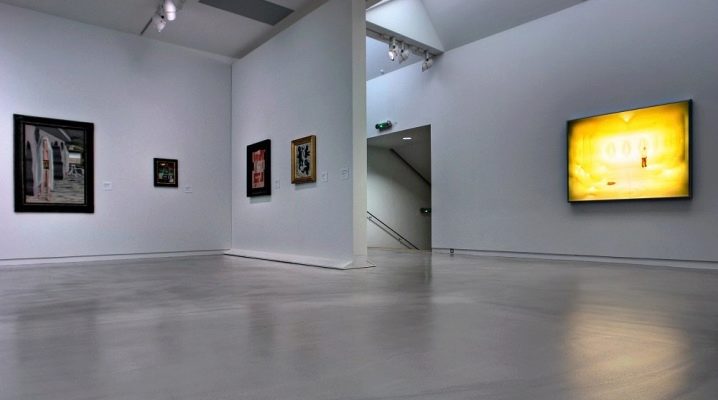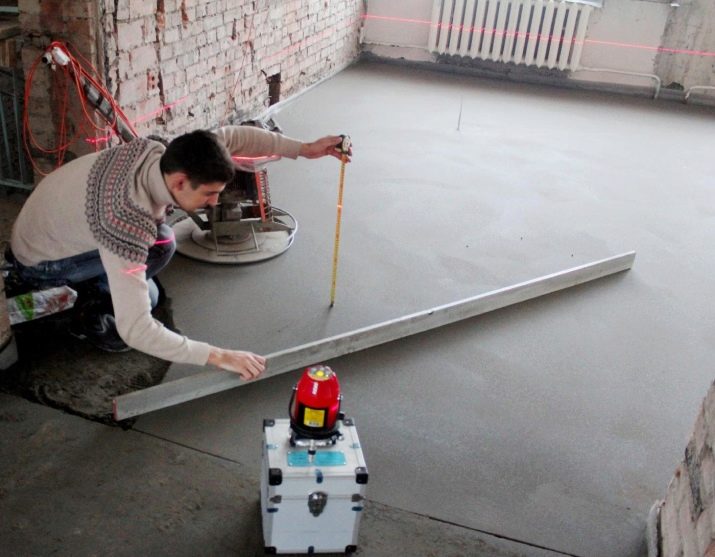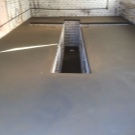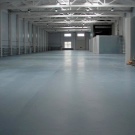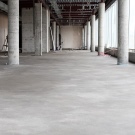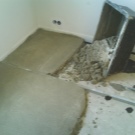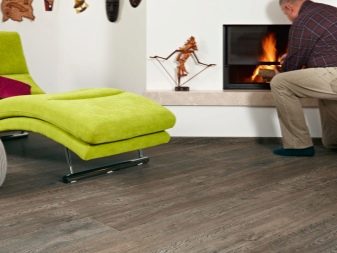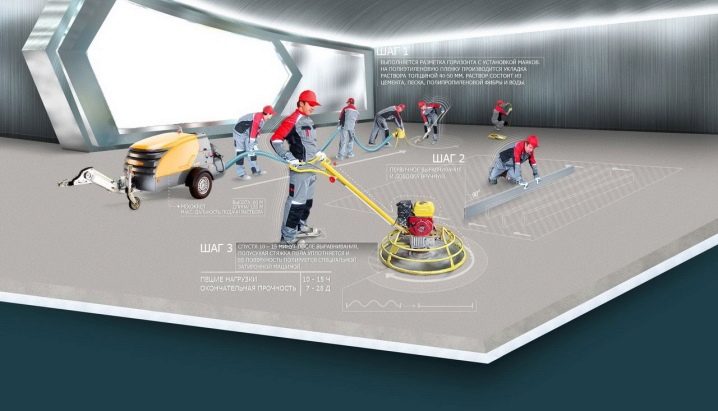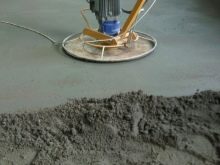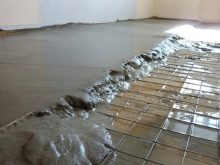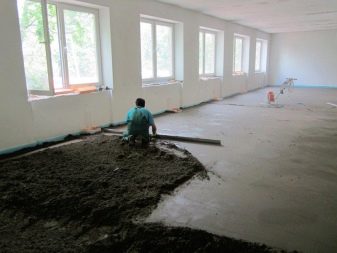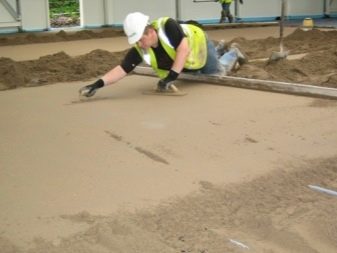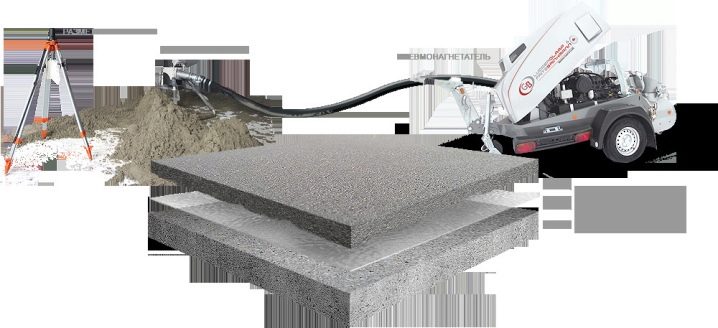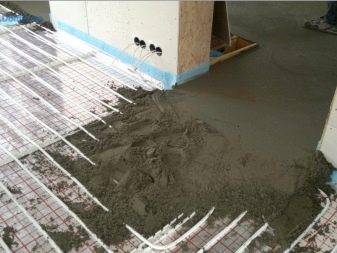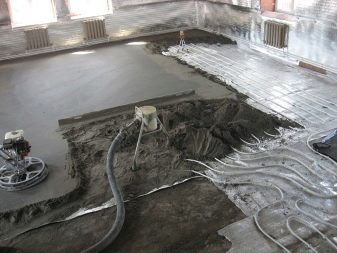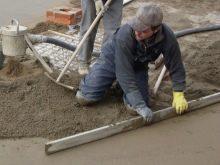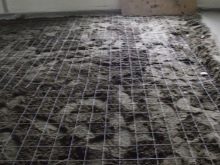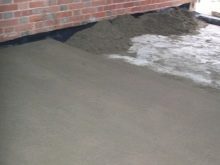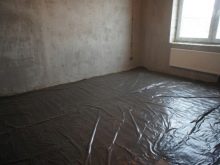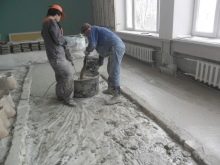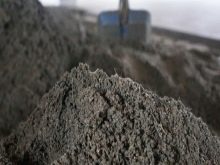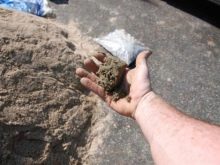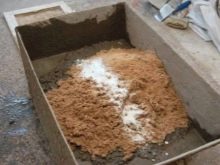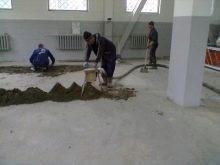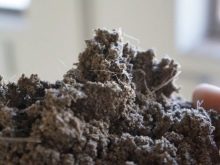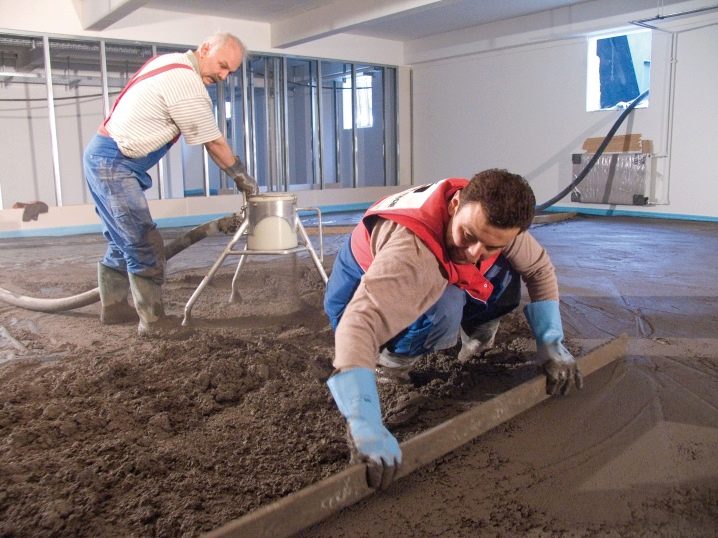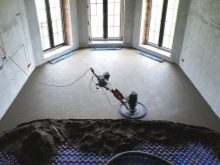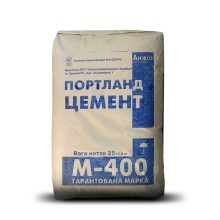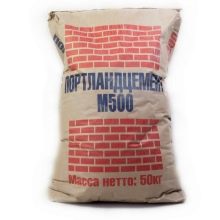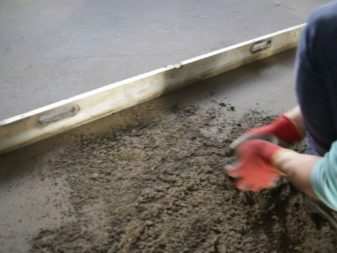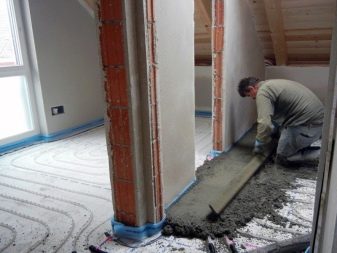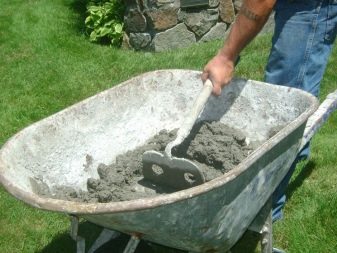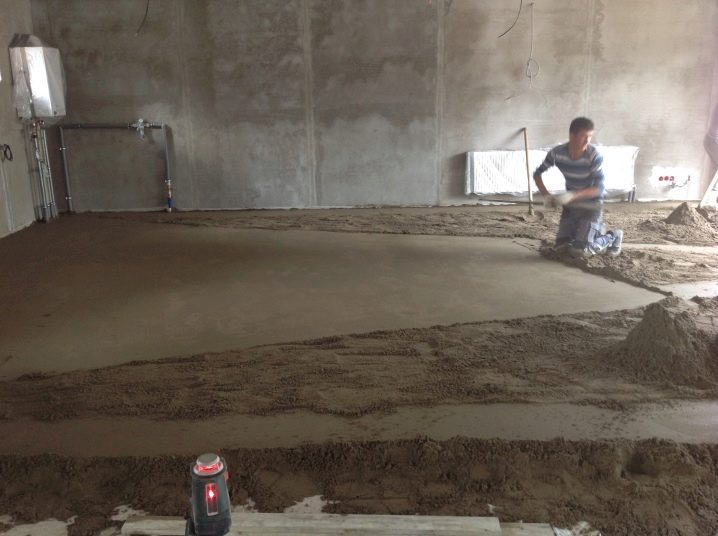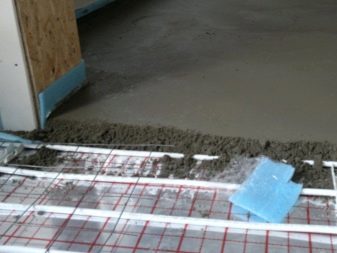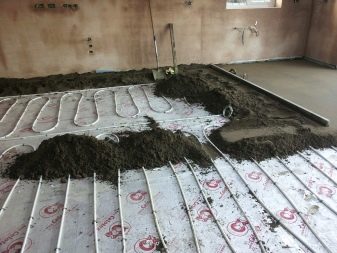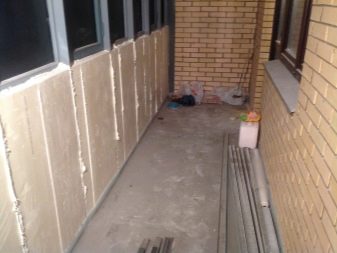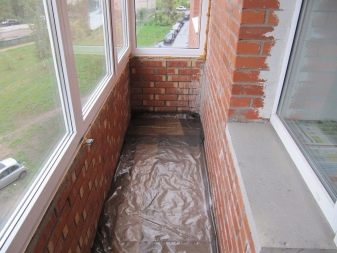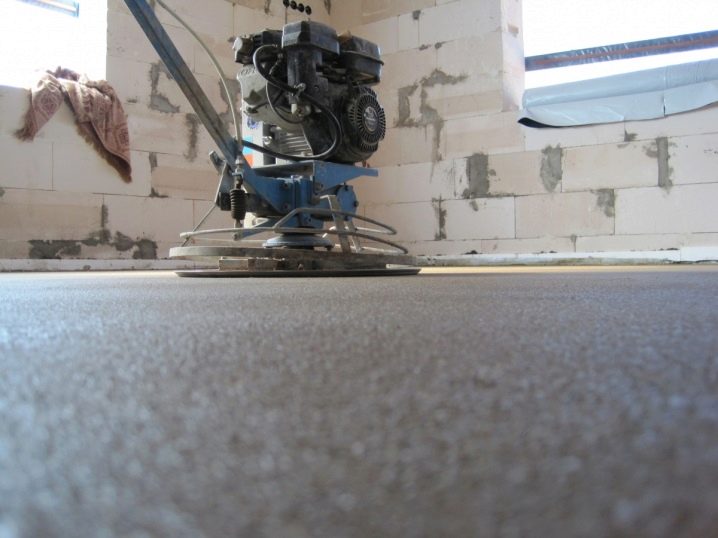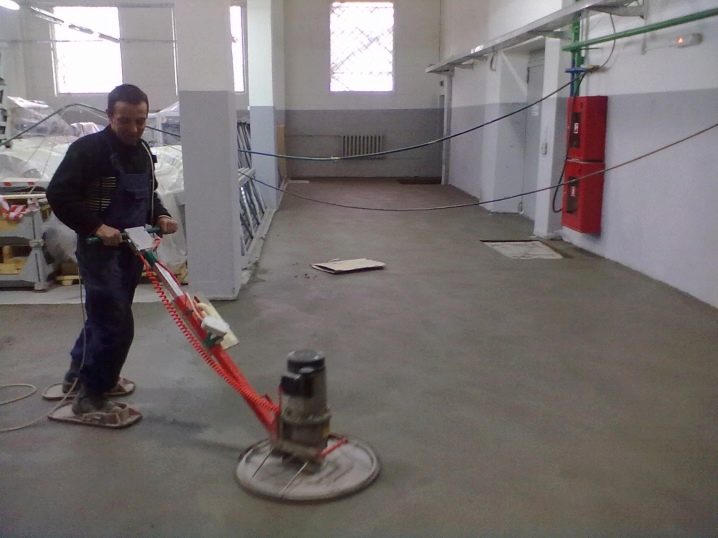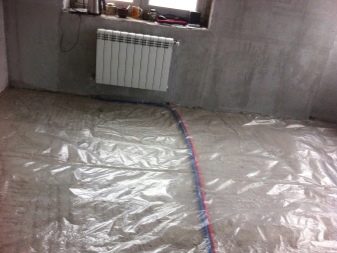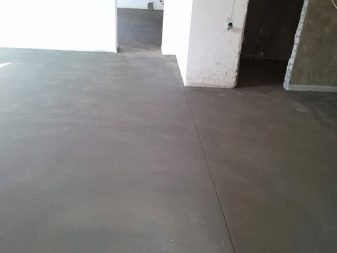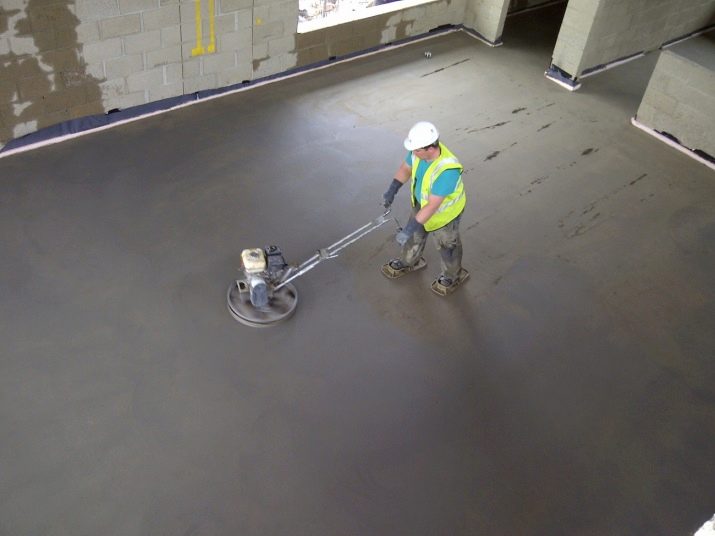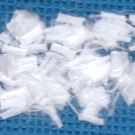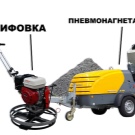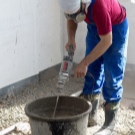Semi-dry floor screed: the pros and cons
In all rooms, the floors are experiencing the greatest load. At enterprises, floor transport drives them, workers and service personnel scurry back and forth. In public places every day hundreds of visitors. In residential premises they walk on floors, move furniture, children jump, hit him with balls and jump ropes.
Floor coverings can withstand various loads for a long time only if they are perfectly laid. Such laying is possible only on a perfectly flat surface. Moist floor screed solves many problems, and it will be discussed in our article.
What it is?
A screed is a layer of cement-sand mortar, laid on the draft floor of the room. The main purpose of the screed - leveling the surface under the finish coat. Lack of screed adversely affects the daily life of people in the room.
Imagine that you have moved into a new apartment, where the draft base is a regular reinforced concrete slab:
- If the stove deviates from the horizontal, the furniture will suffer: irreparable distortions will appear, the doors will not close tightly.
- In the presence of dents and sagging tile floor cracks very quickly.
- Base irregularities will appear in a short time on soft coatings such as linoleum.
- Parquet and laminate will begin to emit unpleasant sounds with each step and will negate all the external beauty.
Arrangement of the screed will allow you to avoid these troubles and save the budget.
By the number of water present in the solution of sand and cement, screeds are divided into:
- Dry Water is completely absent.
- Semi-dry. There is only enough water to make the components mate with each other.
- Wet. There is so much water that the solution flows.
In some cases it is advisable to use only semi-dry species. For example, in apartments and offices of multi-storey buildings.
Advantages and disadvantages
The advantages of the semi-dry variant of laying the mixture are clearly visible in comparison with ordinary and dry screeds. The end result is the same for the wet and semi-dry versions.After solidification of the solution, a solid monolith is formed, similar in hardness to a natural stone.
Semi-dry screed differs from the classic:
- Less water.
- Reduced labor costs.
- Lack of dirt in the work area.
- More comfortable working conditions.
- Reduced drying time.
- The possibility of use in apartments without fear of wetting the premises of the lower floors.
The semi-dry screed is better wet due to the fact that with a minimum water content the created foundation is insured against the appearance of voids. Cement-sand layer is more uniform and dense.
In the usual method all the time drying in the room remains high moisture content. This negatively affects other building structures. Particular harm is caused to wooden products, including windows and doors. If there are dry mixtures in the adjacent rooms, they can deteriorate from an excess of water vapor. A solution with a small amount of water returns to normal several times faster and almost does not emit moisture into the air during setting.
Unfortunately, with a lot of advantages, it has a semi-dry method and some drawbacks:
- The absence of a large amount of water does not allow the ready solution to spread freely. The mixture has to bring and put in the right place. She herself in this "help" does not provide, as is the case with the wet form.
- In order to fill all the voids have to put a lot of effort. To achieve a good result helps tamper. But in connection with this time costs are growing.
- The downside is the inability to manually handle large areas. And the involvement of technical means in the process is not cheap.
- The semi-dry mixture is demanding on the ingredients. Cement must comply with a specific brand, sand - does not contain clay and not be too small.
Kinds
The semi-dry screed stacks in different ways. Its main types include:
- Laying on the basis. The prepared solution is placed on the existing surface without any additional materials. The only condition is that the area should be cleared of debris, and the cavities and cracks should be puttied.
- Laying with insulation. This species is especially relevant for settlements located in central Russia, in Siberia and the northern regions.The insulation may be slab materials such as foam or mineral wool. Recently, under a screed hiding the heating system "warm floor".
- Laying with installation of a sound-proof layer. With this option, the possibility of external noise entering the room is significantly reduced. Sound insulation does not allow outsiders to hear what is happening inside the building. So, loud music or drinking songs will not disturb the neighbors from below. This method is used when, for example, a kindergarten is located in a high-rise building on the upper floors.
- Laying reinforced. Reinforced screed is characterized by the presence of reinforcement. This may be a traditional steel mesh, which increases the strength of the screed.
- Laying with the addition of fiberglass. The base with fiberglass elements is able to withstand very large loads.
- When floating, the base and adjacent walls are covered with a film of polyethylene. A semi-dry solution is placed on a thin substrate. He has no direct contact with building structures. Floating screed is used more often than others, as it is cheaper, has good mechanical strength and long service life.
If necessary, you can combine several species.By creating various combinations, an optimal variant of the subfloor with the desired characteristics is achieved.
Requirements
The following requirements apply to the materials of the solution:
- Sand size module up to 2.5.
- The presence of fine particles of clay in the sand - 3%.
- The complete absence of vegetation residues and vein peat in the sand.
- On the purchased cement bags should not be damaged.
- The material is purchased with a margin of shelf life.
- Use of water from open reservoirs is inadmissible. This component is taken from the plumbing.
Screeds should be insulated from walls, partitions and other building structures with waterproofing materials. After lighthouse strips have been removed, their places of residence will be primed and filled with mortar. The resulting seam smooth down so that it becomes invisible.
Materials and tools
The quality of the semi-dry screed depends on the right materials and equipment, as well as on compliance with the chosen technology.
Necessary materials:
- Cement, sand and water for solution.
- Substrate (heat or sound insulation, if necessary).
- Metal mesh or fiberglass for reinforcement (if necessary).
- Insulating material (damper tape, plastic film).
Each of the materials has a special purpose:
- Cement is the main component of the solution. Brand cement for screed choose, depending on the operating conditions of the floor. For production plants need cement that can withstand heavy loads. Housing requires material that has fewer requirements.
- Portland cement accelerates the drying of the screed, making it resistant to negative temperatures and moisture.
- Sand for semi-dry screeds take coarse washed. The grain size should be within 2-3 mm. Such dimensions provide normal porosity, minimize the number of cracks, give soundproof qualities to the coupler.
- Fiber is convenient to use. Mixing up with other components, threads of polypropylene are distributed in all directions. Due to the chaotic orientation, they reliably bind the formed web, making it more durable and preventing cracking.
- Reinforcing mesh is used infrequently. Its presence undoubtedly increases the strength characteristics of the monolith. However, the installation requires a phased work.Initially, there is a thin layer of solution, then a grid, and only then a second layer. Time costs increase significantly, as well as the complexity of the process.
- The plastic film protects the screed against moisture. The minimum allowable thickness is 200 microns. Frequent use of polyethylene due to low cost.
Do not do when arranging the screed and without construction tools:
- Manually making batches is long and hard. The concrete mixer will do the job quickly and efficiently.
- When the mixer is missing or there is no possibility to deliver bulky equipment to the work site, you can use a construction mixer. When there is no it, the electric drill goes with the corresponding nozzle.
- The horizontal is determined by the level, and the solution is leveled (by hand) with a rule, a trowel and a scraper.
- When laying the screed on large areas, you need special equipment - a pneumosupercharger, as well as flexible hoses. This unit is mounted on a trolley and easily moved by one person. In such cases it is better to perform tamping not by hand, but by a special technical device - a vibrating plate.
Composition
The basic composition of the semi-dry screed is three components.Cement is taken in two grades: M500 or M400. Sand is needed only clean and only large. The third element is water, not necessarily drinking, but necessarily plumbing.
The M150 grade solution used for residential and domestic use is produced by mixing clean sand and cement of the M400 grade. The proportions of the mixture are 3: 1, that is, 3 parts of sand need 1 part of cement. To make a mistake with the proportions is impossible. They are always on the cement packaging.
The amount of water required is definitely not known. It is determined "by eye". If the ready-mix when compressed by hand forms a tight lump, you can get to work. If water drops appear, cement-sand steam requires the addition of dry ingredients. The proportions in this case should not be violated.
Additional components - plasticizers, fiberglass and other additives may or may not be present at all. With a layer thickness of 50 mm, each square meter experiences a load of 110 kg. The presence of supplements does not increase the weight by 1 square. m floor, and the benefits of them a lot.
Plasticizers facilitate the placement of concrete by increasing its flowability. The average consumption of plasticizer is 1 liter per 1 m3 of the finished solution.In order to prepare a solution with fibers, you need to add reinforcing particles in portions in the process of mixing the solution. At a rate of 600 to 800 g of fibers per 1 m3 of the mixture.
For cottages, where the overlap of the first floor is a concrete slab, under the semi-dry screed, you can make the substrate with expanded clay. A clean floor with such a pillow will rise and thoroughly insulate.
The cost of materials and work translated into 1 m2 is higher, the smaller the room. Thus, in small rooms ranging from 10 to 15 m2, a square meter will cost more than in spacious rooms of 30 m2 and more.
Payment
Material consumption is determined by calculation.
Let's pretend that:
- The area of the room is 20 m2.
- The thickness of the screed 4 cm (0.04 m).
- Used cement brand M500.
- The ratio of cement / sand - 1/4.
- According to the construction tables, we determine: to get 1 cu. m of M150 grade solution will need 330 kg of cement M500.
- The volume of the screed is equal to the product of the area by the thickness: 20x0.04 = 0.8 m3.
- If 330 kg of cement are needed for 1 m3, then it will go to 0.8 m3: 330x0.8 = 264 kg.
- The need for sand: 264x4 = 1056 kg.
- The need for fiberglass: 0.7x0.8 = 0.56 kg (0.7 kg per 1 m3 screed).
- The amount of plasticizer: 1x2.64 = 2.64 l (1 l per 100 kg of cement).
Knowing the mass and volume of materials, one can determine their cost.
Laying technology
The installation of a semi-dry floor screed requires certain conditions:
- When laying in accordance with the German technology using the mechanized method, it is allowed to carry out work to obtain a solution at sub-zero temperatures. In this case, the automated installation must be forcibly heated. Equipment special "greenhouse" will provide the required conditions. Screed laid out indoors at + 5 degrees. If this requirement is not met, the process should be postponed to a warmer time.
- It doesn’t matter how the floor is done using the semi-dry method: do it yourself or use the machine version. First, two points are found on the floor: the lowest and the highest. The count of the thickness of the layer comes from the highest point of the treated surface. It’s best to markup with a laser level.
- The cleaned floor is covered with a film or other required material, and the walls around the perimeter are glued over with a damper tape. At the preparation stage, if necessary, beacons are installed. If the installation of the solution goes through the lags, the beacons are not installed.
- The semi-dry screed is laid out immediately after kneading for the entire planned height. The minimum layer thickness is 40 mm.The alignment of the floor is performed by the rule of beacons or lags.
If it is decided to do the screed on a water-heated floor, the technology changes somewhat. First, waterproofing is laid, then pipes are laid along the entire surface of the floor. From the thickness of the layer depends on the effectiveness of a warm floor. The smaller the distance from the water pipes to the floor covering, the faster the floor will heat up.
It is very important to thoroughly seal the solution. Otherwise, some of the heat just does not reach the destination. Manually in a timely manner to carry out the arrangement of semi-dry screed on a warm floor will be possible only in a small room. For large areas, mechanical laying, tamping and sanding would be appropriate.
On areas exceeding 45 m2, deformation seams are made in the body of the screeds. The laid out layer is incised by 2/3 of the thickness. This preserves the strength of the screed, prevents cracking during its shrinkage.
If you put a semi-dry screed on the balcony with cold glazing, your feet will be much more comfortable. Balconies are often used as warehouses of unnecessary things. Warming the floor makes a cold room in a wonderful place to rest.
A semi-dry leveling tie can be installed on the wooden floor only after the boards have dried completely. This happens no earlier than 3 years after their flooring.
If the lags under the floorboards lie directly on the floor slab, then only a floating floor can be equipped. It will not come into contact with the wooden flooring. The thickness of the floating screed cannot be more than 5 cm. Excessive load on the floor will lead to its destruction.
If it is required not only to level the floor, but also to raise it to a height of more than 10 cm, you should use the combined method. It is quite easy. Expanded clay can serve as a substrate. It weighs a little, so the owner of the cottage is able to do all the work himself without the involvement of third parties and additional costs.
First, determine the height of the screed, the remaining height will have a layer of expanded clay. In order to prevent the granules from scattering under the cement-sand mass, the impregnation of the cement jelly is applied on the top layer of the expanded clay. During the process of arranging the floor, the ambient temperature should be positive.
The surface of the lined layer dries faster than the inside.If nothing is done, inevitably cracks will appear. This will not happen if the stove is watered independently from a spray bottle as it dries.
Operation and care
The finished screed is subjected to aging. The minimum period is 7 days. During this time, the surface should be under the cover of plastic film.
Special care requires screed in rooms with low humidity and high temperature. Under similar conditions, in the first 3-5 days the surface should be moistened periodically. This procedure will prevent the appearance of cracks.
After removing the film, you must allow time for the final drying in the open air. The longer you don’t start flooring, the better. Month is the perfect time. Even when the repair time is tight, it is impossible to resort to forced drying with heating devices.
How long does it dry?
Due to the low moisture content, semi-dry screed does not spread. Walking on it without causing even minimal damage can be a day later. A week later, the view of the cement-sand monolith is quite working. And yet with the finishing of the floor is a little wait.
There are three main factors that affect the drying rate of the solution:
- Relative humidity in the room. The higher it is, the longer it will take to completely remove moisture from the body of the screed. The preferred moisture content during drying is 65%.
- The temperature in the room. At low temperatures, the drying process slows down. Too high a temperature adversely affects the strength characteristics of the flooring. The best option is 20-25 degrees.
- Layer height
It has been established by practice that, under normal conditions, a plate with a thickness of up to 5 cm will dry out within 15 days. With a thickness of 7 cm, the result will be achieved in 3 weeks. On drying a layer of 10 cm will take a whole month.
The estimated drying time in the apartment under the laminate depends on the height of the screed and ensure good conditions. As in a private house, and in the panel "Khrushchev" the requirements for the maintenance of the laid flooring to complete drying are the same.
And in the new building, where there is no heating, drying will take more time. In winter, the coupler can not be done. The solution will be able to dry out if it is put in 1.5-2 months before the onset of cold weather.
There is a special instrument for determining humidity.True, its value is such that few people dare to acquire it, unless it is engaged in the construction business.
Experienced builders offer a free and reasonably reliable way to determine the readiness of a screed for finishing. A paper napkin is put on the surface of the plate, covered with polyethylene. If the napkin stays dry in a day, you can lay a clean floor. Moisture on a napkin will indicate that the floor is not ready for further processing.
Reviews
Judging by the reviews of people who dared to independently perform a semi-dry floor screed, the only difficulty was the selection of water. The first batches took a lot of time: you had to add water, then cement with sand. Over time, experience appeared, and the desired consistency was visible "by eye".
Proper selection of water is very important. If it is not enough in the solution, then in the future, with the penetration of moisture, crystallization of the material will begin. Floors will start to creak. It is worth spending time and adapt to the exact definition of proportions. Then work will go quickly, and the result will please.
Successful examples and options
For best results, follow these guidelines:
- The addition of fibers to the solution makes the coupler resistant to any stress.
- It is possible to ram the solution laid in an apartment or house, not only with your hands, but also with your feet. Walk on the lined seam. It is perfectly compacted.
- The optimal solution temperature is 5 degrees.
- If hot water is introduced into the cement-sand mixture not cold, but the solution will be more plastic. The maximum temperature of hot water is 80 degrees.
- Do not rush to the final floor. Let the screed dry thoroughly. Then the tile will not crack, and the parquet will not creak.
Do not deviate from the rules, and successful repair!
You can get acquainted with the process of laying dry screed in the next video.
